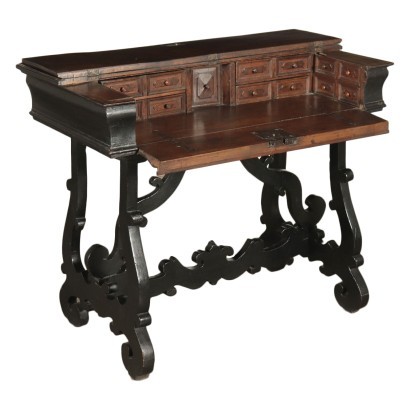Scrittoio a San Filippo
Features
Age: 18th Century / 1701 - 1800 , 17th Century / 1601 - 1700
Origin: Lombardia, Italy
Main essence: Boxwood , Walnut , Poplar
Description
Rifinito a giorno, è sorretto da gambe a lira con traverse e saette sagomate e intagliate; il piano e la calatoia a ribalta sono apribili, dando accesso al piano interno con scrittoio, vani, cassettini portadocumenti e vari segreti. I piccoli cassetti dello scarabattolo e l'antina sono in noce, ornati con elaborati cornici intagliate; i pomelli sono in bosso, mentre gli interni in pioppo. In noce ebanizzato, il mobile ha subito restauri e sostituzioni, come nel caso delle cerniere del piano, sostituite successivamente.
Product Condition:
Prodotto in discrete condizioni che mostra alcuni segni di usura.
Dimensions (cm):
Height: 87,5
Width: 101,5
Depth: 58
With certificate of authenticity
Certificate issued by: Enrico Sala
Additional Information
Age:
18th Century / 1701 - 1800
18th Century / 1701 - 1800
17th Century / 1601 - 1700
17th Century / 1601 - 1700 Main essence:
Boxwood
With a yellowish color, it is a very compact and hard wood, of oriental origin, which is obtained from evergreen shrubs of the Buxaceae family. It is used for inlays and for all-round workings both as furniture finishes and as small objects and sculptures.
Walnut
Walnut wood comes from the plant whose botanical name is juglans regia , probably originally from the East but very common in Europe. Light or dark brown in color, it is a hard wood with a beautiful grain, widely used in antique furniture. It was the main essence in Italy throughout the Renaissance and later had a good diffusion in Europe, especially in England, until the advent of mahogany. It was used for solid wood furniture and sometimes carvings and inlays, its only big limitation is that it suffers a lot from woodworm. In France it was widely used more than anything else in the provinces. In the second half of the eighteenth century its use decreased significantly because mahogany and other exotic woods were preferred.
Poplar
Essence considered "poor", it is a white wood, with yellowish or greyish shades, light and tender, which is easily damaged. It is used for rustic furniture or in the construction of furniture. The most valuable use it has had in the history of furniture is in Germany, in the 19th century, for veneers and inlays in the Biedermeier period. 




























